The concept of sleepers has changed a lot over the years due to the explosion of available data and analysis. It’s hard to find a “hidden gem” in the middle rounds of your draft, but there are still players who are undervalued, underappreciated, or who have electric upside that may be overlooked or disregarded due to other concerns.
This article focuses on those players in order of ADP (specifically, NFBC data for drafts that finished on or after February 1), who are available after the first 10 rounds of a 12-team draft, though not so late in the draft that they’d be a late round flyer, which is covered in this article. The excerpts in this piece come from my Top 300 Hitters for 2024, where you can also see how I ranked these players in a fuller context.
Willson Contreras (C, STL), ADP 140 – After a rocky start in St. Louis, Contreras hit 20 home runs and chipped in over 120 combined runs and RBI for the fourth time in as many 162-game seasons. I see no reason Contreras can’t do that again, and that kind of floor is extremely rare at catcher.
Jake Burger (3B, MIA), ADP 152 – Many have probably noticed that Burger’s strikeout rate was markedly better after moving to Miami, but as the rolling chart below shows, he started making this change well before the trade. Burger’s floor is very much tied to how often he can make contact when he swings due to his immense power, and if the strikeout rate improvement sticks, then this ranking will turn out to be far too low. There’s reason to believe he can hold on to it though, as he showed exceptional decision-making skills against breakers and improved against fastballs as the season went on. If he can keep making good decisions against the breaking balls and be even average against fastballs, he could be a force.
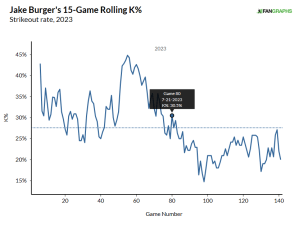
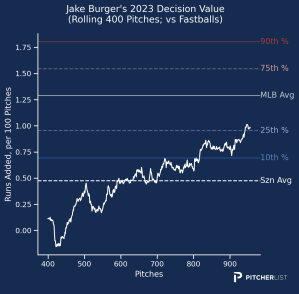
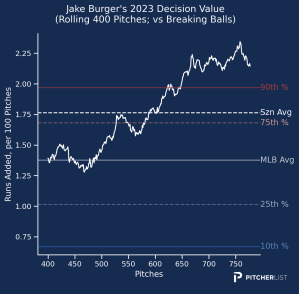
Christian Encarnacion-Strand (1B/3B, CIN), ADP 164 – The young slugger still has a lot of work to do on his decision-making, but the raw power started to shine towards the end of the season. Decision-making is a much more “learnable” skill than contact ability or power, so hopefully an offseason and more time with the big league club will get Encarnacion-Strand where he needs to be to unlock his peak 35+ home run power. Playing time is a huge issue due to the very crowded infield (especially at the corners) in Cincinnati, so for now CES remains a lottery ticket.
Ke’Bryan Hayes (3B, PIT), ADP 179 – Health has been an issue for Hayes in each of the last three seasons, but it was great to see Hayes hit those 15 home runs in 124 games as it was more than he’d hit in the 232 games he played in 2021 and 2022. His aggressive approach will likely keep his OBP low, but the growth in Hayes’s power was real, and if he can have some better luck on the health side, we could see a 20-20 season. Sure, it’ll be on a bad Pirates offense that caps his counting stat totals, but it’s still pretty exciting.
Isaac Paredes (1B/3B, TBR), ADP 181 – I have been on board for quite some time due to the hit tool and the way the Rays have used that skill and turned it into home runs. Despite the lower batting average, Paredes remains a guy who is excellent at making contact, and as long as he has an everyday role, I’m all in on another 28-30 home run season for Paredes and another 90+ RBI. I also believe he can repeat the .250 batting average due to his ability to avoid strikeouts and his willingness to take a walk rather than chase bad pitches.
Paredes happens to be an example of how expected stats can be misleading for players with specific skill sets. Baseball Savant’s expected batting average does not take batted ball direction into account because it is often fluky and year-to-year pull rates are not usually that sticky. That said, some players do make specific, intentional changes to their batted ball profile (like Paredes has), and it allows them to overperform those expected stats quite significantly.
Lars Nootbaar (OF, STL), ADP 204 – Injuries once again limited Nootbaar to fewer than 120 games in the big leagues, but he still managed to show the power, speed, and on-base skills that caught our attention in 2022. Nootbaar looks like a good fit for the top third of the lineup, and if he can seize that opportunity, we could be looking at 23-25 home runs, 150-160 combined runs and RBI, 13-15 steals, and solid ratios. Those are all dependent on health and lineup position, though, and Nootbaar has yet to show consistency with either, but the upside is very real.
Edouard Julien (2B, MIN), ADP 206 – In his very first exposure to the majors and being only 24 years old, Julien showed he is and will likely continue to be among the best decision-makers in the league (see below) and can punish fastballs.
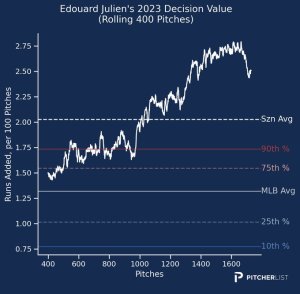
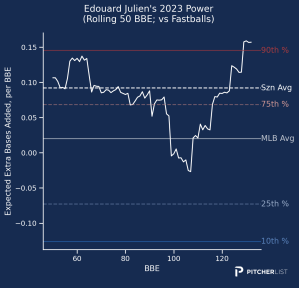
This is an excellent starting point to launch a successful 2024 season, though it’s worth noting that there are weaknesses in how he performs in both contact and power against breakers and offspeed pitches. That particular weakness isn’t unique to Julien, though, as many young players struggle to adjust against how well major league pitchers can use these weapons compared to minor leaguers. I believe there’s room for Julien to learn how to deal with these pitches, and it could lead to 20 home runs with 90+ runs scored if he can stay at the top of the Twins’ lineup.
Brandon Drury (1B/2B, LAA), ADP 217 – So much for a power regression, eh? Drury only played in 125 games in 2023, but still managed to hit 26 home runs for the Angels as a follow-up to the 28 he hit back in 2022. I’m inclined to believe that the Drury we saw in 2022 and 2023 is the one we will get in 2024, and that means a .260 batting average, 25-27 home runs, and 150 combined runs and RBI over a full season.
Of course, Drury isn’t known for playing full seasons as he’s never played in 140 games in a season since going pro in 2010. He missed significant time in 2018, 2019, 2020, and 2021, so projecting more than 120 games is a big risk to take. That said, in shallow leagues, he remains an excellent back-end infielder who can provide power and RBI while batting in the heart of the order for a bad team.
Starling Marte (OF, NYM), ADP 217 – Injuries loom large for Marte as he enters his age-35 season but in just 86 games he managed to steal 24 bases in the new environment for the Mets. I’d advise against projecting Marte for more than 110-120 games, but the upside even in that short time could be 10-15 home runs and over 30 steals. That kind of upside is hard to come by at this stage, and in shallow leagues, it makes Marte worth scooping up near the end of the draft.
Eloy Jiménez (OF, CWS), ADP 229 – Health continues to evade Eloy as he played in just 120 games in 2023. From a talent perspective, he should be a .280+ hitter who hits 30 home runs and drives in 90 runners regularly, but the sheer number of injuries he’s suffered over the last three seasons makes that kind of projection much harder to imagine. Jiménez’s upside keeps him in my preseason top 100, but I’d need to feel pretty good about my power and consistency in the outfield to consider drafting him where he’ll likely be going.
Byron Buxton (UT, MIN), ADP 247 – 2017 stands alone as the sole season where Buxton played at least 100 major league games as he found his way into just 85 of them in 2023 before hitting the IL. The Twins still expect him to be their starting centerfielder, and we saw enough to still project Buxton for 30 home runs if he somehow plays in 140 games and could also steal 15 bases. We also saw enough to know that Buxton’s ratios are probably going to stay low due to his extreme flyball tendencies, but if you want to pick up a lottery ticket, Buxton still fits the bill.
Brandon Lowe (2B, TBR), ADP 266 – Lowe has the pop to hit 30 home runs, but injuries, inconsistency, and platoon splits continue to hold him back. If you’re desperate for power late in the draft, Lowe is a gamble worth considering, but at this point, it’s just a gamble.
Feature image by Michael Packard (@CollectingPack on Twitter) | Photo by Mark LoMoglio / Icon Sportswire
